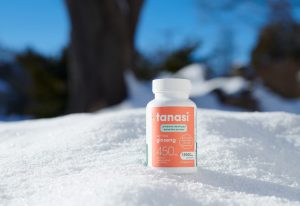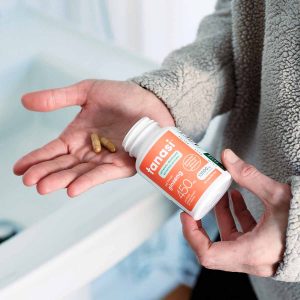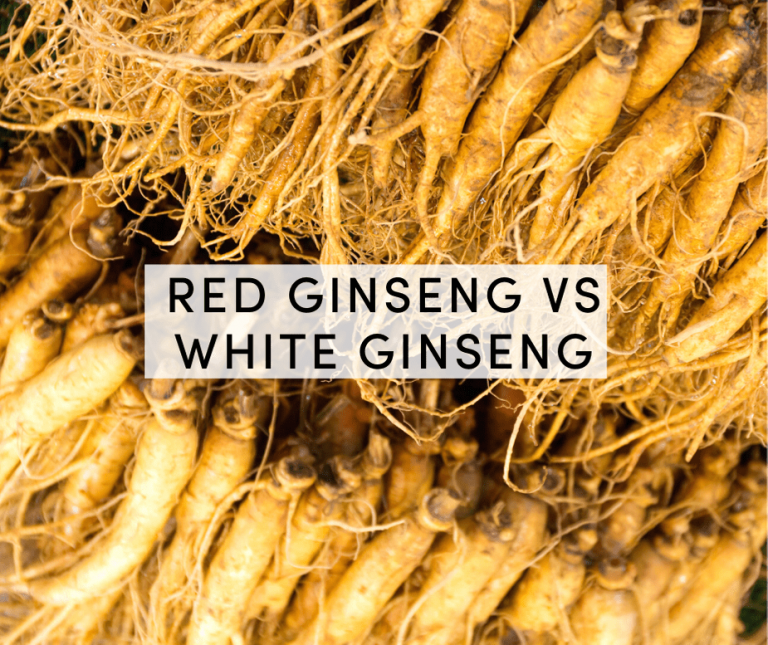Red Ginseng vs White Ginseng: What’s the Difference?
Posted on February 23rd, 2023
Ginseng is a traditional ingredient in Chinese medicine that has been a popular herbal supplement for centuries. It’s among the most sought-after herbal ingredients, and that’s why we’ve recently returned this supplement to our line of products. Like our plant-based, CBD+CBDa supplements (based on our patent-pending 1:1 formulation that’s 2X more effective than CBD alone), ginseng offers a natural way to supplement your lifestyle, based from products we derive from the earth.
The ginseng plant is made up of a relatively long stalk and green oval-shaped leaves. Products of this slow-growing, short herb are divided into three main types, depending on the duration it is grown: red, white, or fresh. This article will mostly discuss red ginseng vs white ginseng.
If you reap ginseng before 4 years, you call it fresh. Red ginseng should grow for more than 6 years, and white ginseng between 4-6 years. There are various species of this plant, but the most renowned are Asian ginseng and American ginseng. Asian and American ginseng have different concentrations when it comes to active compounds and their impact on the body. Some say that Asian ginseng has a stimulating effect while American ginseng acts as a relaxing agent. Both Asian and American are popular supplements in many people’s daily routines.
Ginseng consists of two main compounds: gintonin and ginsenosides. They complement each other to produce ginseng’s effects in your body. Researchers have discovered 100+ ginsenosides, and their concentrations differ from root to root depending on factors like soil conditions, altitude, climate, and age of the root.
Red Ginseng vs White Ginseng
To start with, neither white nor red ginseng is necessarily better than the other. The only real distinction between the two is how they are harvested and made.
Red ginseng comes from an old Korean method of steaming and drying. This process is done continuously until the ginseng becomes reddish in color. In ancient times, this was the only way of preserving the plant but it also increased the concentration of certain ginsenosides. In traditional customs, red ginseng is seen as a ‘warming’ herb while white ginseng is considered a ‘cooling’ herb.
The ginseng quality is contingent on the quality of its root, which takes some time to create the active compounds – the ginsenosides.
Red and white ginseng don’t come from different plants as most people assume. In fact, they come from the same plant variety, Panax Ginseng C.A. Meyer.
 Red Ginseng
Red Ginseng
Legal regulations mandate that only ginseng roots that are at least six years old can be made into red ginseng. However, legal restrictions have recently been lifted and younger, less developed roots may now also come into products.
To become ‘red ginseng’ the roots will have to undergo extra treatment referred to as the Maillard method:
After the initial white roots are reaped, arranged according to size, and cleaned, they are subjected to hot air flow at around 120 to 130 ° C. Because of this, the roots become reddish in color and their surfaces get hard and glassy. This heat treatment destroys certain enzymes. After this stage in the processing cycle, the now “red” ginseng undergoes the drying process.
Red ginseng is basically white ginseng that has been processed for added effects, and that is the reason why it’s considered a premium (and more expensive) product.
White Ginseng
Conversely, ‘white ginseng’ is dried right after harvesting and then made available in powdered form or as a dry root.
For Asian imported products, white ginseng processing often begins in the 3rd or 4th year of development, which will consequently have an effect on the effectiveness and quality of the product. What’s more, in most of these countries, they peel the outer layer of white ginseng, to make it appear aesthetically pleasing.
Benefits: Red Ginseng vs White Ginseng
People have used ginseng for thousands of years for many different reasons.
More studies are required to ascertain its advantages as a supplement. In fact, health professionals and western scientists often question the medical properties of ginseng. As of yet, there is no conclusive evidence proving the effectiveness of ginseng. Ginseng products vary in terms of their quality. You should always check the full list of ingredients before you buy any product. Because ginseng can be expensive to produce, less reputable manufacturers may include cheaper, or even harmful, ingredients in the ed product.
Always take claims of ginseng benefits with a grain of salt. More research and regulation of ginseng are required before any conclusive health claims can be made.
Side Effects
Data is uncertain about all the possible side effects that ginseng could cause. Even though ginseng is generally safe to ingest, here are some of the side effects that have been reported:
-sleep problems
-digestive problems
-headaches
-blurred vision
-irritability
-changes to blood sugar and blood pressure
-nervousness
-diarrhea
-edema
-bleeding
-dry mouth
-dizziness
-delirium
-reduced heart rate
Pricing
Ginseng is costly because some individuals believe its roots are a good medicinal source and can even act as an aphrodisiac. In general, red ginseng is more costly than white ginseng because it has undergone further processing which contributes to the price increase.
 Easy to Add to Your Diet
Easy to Add to Your Diet
You can ingest the ginseng root in a variety of ways. Lightly steaming it will soften it, or you can eat it raw. Also, you can stew it to make tea. You only need to add hot water to ginseng you’ve sliced up and allow it to steep for a few minutes.
Ginseng is available in capsule form here at Tanasi. Our 1350 mg jar contains 30 capsules, each delivering a 450mg dose of red ginseng.
The quantity you consume is contingent on what you want to improve. The typical recommendation is 200-500 mg of ginseng extract or 1-2 grams of raw ginseng root daily. Begin with smaller doses and increase them with time.
Go for a ginseng extract with 2-3% ginsenosides, and take it before meals to improve the absorption rate and experience the full effects.
Takeaway: Red Ginseng vs White Ginseng
Although scientists don’t all agree on all the health benefits of ginseng, it’s still safe to consume. And if it has positive effects on you, by all means, go for it! Tanasi sells a very high-quality red ginseng capsule for your easy supplementation. Feel free to compare it to other brands, secured by the promise of our 30-day satisfaction-guarantee and, before taking this or any supplement, be sure to consult with a physician first to ensure it won’t interact with any other supplements or medications, or affect your health in any way.

 Red Ginseng
Red Ginseng Easy to Add to Your Diet
Easy to Add to Your Diet
